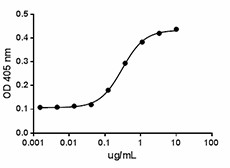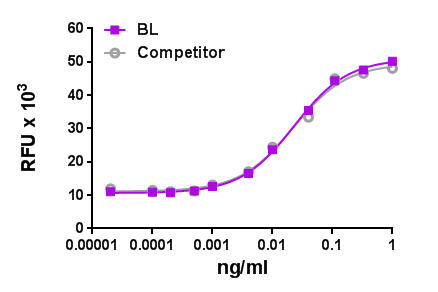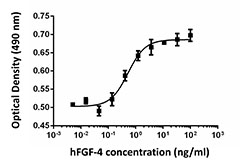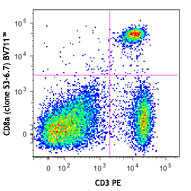- Regulatory Status
- RUO
- Other Names
- SHH, TPT, HHG1, HLP3, HPE3, SMMCI, TPTPS, MCOPCB5
- Ave. Rating
- Submit a Review
- Product Citations
- publications

-

Recombinant Human SHH induces C3H10T1/2 differentiation in the presence of hBMP9 (20 ng/mL) as measured by alkaline phosphatase production. Alkaline phosphatase activity was measured using p-nitrophenyl phosphate.
Human Sonic Hedgehog (SHH) encodes a 462 amino acid precursor protein. It undergoes autocatalytic internal cleavage to yield a non-glycosylated 19 kD N-terminal fragment, which has signaling activity, and a glycosylated 25 kD C-terminal protein that is active in precursor processing. The SHH N-terminal fragment is highly conserved between species with >98% amino acid identity between human, mouse, and rat. Lipid modifications of the SHH N-terminal fragment enhances its binding affinity and modulates interactions with the Patched and Smoothened transmembrane receptors. SHH activity is attenuated by its interaction with membrane-associated Hip. On the other hand, interaction with glycan can lead to the stimulation of SHH signaling. SHH is expressed in embryonic tissues that are critical for the patterning of early embryos. It functions as the key inductive signal in patterning of the ventral neural tube, the anterior-posterior limb axis, and the ventral somites. SHH regulates the differentiation and proliferation of early thymocyte progenitors and it also regulates the neural and hematopoietic stem cell fates. In adult tissues, SHH is associated with cancer development and tissue remodeling following injuries. Gastric SHH acts as a macrophage chemoattractant during the immune response to Helicobater pylori.
Product DetailsProduct Details
- Source
- Human SHH, amino acids (Cys24-Gly197) (Cys24Ile-Ile) (Accession# NP_000184), with a N-terminal Met was expressed in E. coli.
- Molecular Mass
- The 176 amino acid recombinant protein has a predicted molecular mass of approximately 19.8 kD. The protein migrates at approximately 22 kD in both DTT-reducing and non-reducing conditions by SDS-PAGE. The predicted N-terminal amino acid is Met.
- Purity
- >95%, as determined by Coomassie stained SDS-PAGE.
- Formulation
- 0.22 µm filtered protein solution is in 10 mM sodium phosphate buffer, 0.3M NaCl, and in pH 7.2
- Endotoxin Level
- Less than 0.01 ng per µg cytokine as determined by the LAL method.
- Concentration
- 10 and 25 µg sizes are bottled at 200 µg/mL. 100 µg size and larger sizes are lot-specific and bottled at the concentration indicated on the vial. To obtain lot-specific concentration and expiration, please enter the lot number in our Certificate of Analysis online tool.
- Storage & Handling
- Unopened vial can be stored between 2°C and 8°C for up to 2 weeks, at -20°C for up to six months, or at -70°C or colder until the expiration date. For maximum results, quick spin vial prior to opening. The protein can be aliquoted and stored at -20°C or colder. Stock solutions can also be prepared at 50 - 100 µg/mL in appropriate sterile buffer, carrier protein such as 0.2 - 1% BSA or HSA can be added when preparing the stock solution. Aliquots can be stored between 2°C and 8°C for up to one week and stored at -20°C or colder for up to 3 months. Avoid repeated freeze/thaw cycles.
- Activity
- ED50 = 0.15 - 0.6 µg/mL as measured by its ability to induce C3H10T1/2 cell differentiation in the presence of hBMP9 (20 ng/mL) as measured by alkaline phosphatase production.
- Application
-
Bioassay
- Application Notes
-
BioLegend carrier-free recombinant proteins provided in liquid format are shipped on blue-ice. Our comparison testing data indicates that when handled and stored as recommended, the liquid format has equal or better stability and shelf-life compared to commercially available lyophilized proteins after reconstitution. Our liquid proteins are verified in-house to maintain activity after shipping on blue ice and are backed by our 100% satisfaction guarantee. If you have any concerns, contact us at tech@biolegend.com.
- Additional Product Notes
-
View more applications data for this product in our Scientific Poster Library.
- Product Citations
-
Antigen Details
- Distribution
-
Notochord, fetal intestine, liver, lung, and kidney.
- Function
- SHH is essential in the patterning of early embryo, differentiation of the gastric epithelium, and T cells.
- Interaction
- Ventral neural tube, ventral somites, limb axis in developing embryo, and hematopoietic stem cells.
- Ligand/Receptor
- Patched-1 (PCTH1), patched 2 (PCTH2), and smoothened (SMO).
- Bioactivity
- SHH enhances BMP9 induced differentiation of C3H10T1/2 cells.
- Biology Area
- Cell Biology, Neuroscience, Stem Cells, Synaptic Biology
- Molecular Family
- Cytokines/Chemokines, Growth Factors
- Antigen References
-
1. Echelard Y, et al. 1993. Cell 75:1417-1430.
2. Marigo V, et al. 1995. Genomics 28:44-51.
3. Porter JA, et al. 1996. Science 5285:255-9.
4. Zeng X, et al. 2001. Nature 411:716-720.
5. Johnson RL, et al. 1997. Cell 90:979-990.
6. Briscoe J, Therond PP. 2013. Nat. Rev. Mol. Cell Biol. 14:416-29.
7. Filmus J, Capurro M. 2014. Matrix Biol. 35:248-52.
8. Chuang PT, McMahon AP. 1999. Nature 397:617-21.
9. Crompton T, et al. 2007. Nat. Rev. Immunol. 7:726-35.
10. Shiotani A, et al. 2005. Am. J. Gastroenterol. 100:581-7. - Gene ID
- 6469 View all products for this Gene ID
- UniProt
- View information about Sonic Hedgehog on UniProt.org
Related Pages & Pathways
Pages
Related FAQs
- Why choose BioLegend recombinant proteins?
-
• Each lot of product is quality-tested for bioactivity as indicated on the data sheet.
• Greater than 95% Purity or higher, tested on every lot of product.
• 100% Satisfaction Guarantee for quality performance, stability, and consistency.
• Ready-to-use liquid format saves time and reduces challenges associated with reconstitution.
• Bulk and customization available. Contact us.
• Learn more about our Recombinant Proteins. - How does the activity of your recombinant proteins compare to competitors?
-
We quality control each and every lot of recombinant protein. Not only do we check its bioactivity, but we also compare it against other commercially available recombinant proteins. We make sure each recombinant protein’s activity is at least as good as or better than the competition’s. In order to provide you with the best possible product, we ensure that our testing process is rigorous and thorough. If you’re curious and eager to make the switch to BioLegend recombinants, contact your sales representative today!
- What is the specific activity or ED50 of my recombinant protein?
-
The specific activity range of the protein is indicated on the product datasheets. Because the exact activity values on a per unit basis can largely fluctuate depending on a number of factors, including the nature of the assay, cell density, age of cells/passage number, culture media used, and end user technique, the specific activity is best defined as a range and we guarantee the specific activity of all our lots will be within the range indicated on the datasheet. Please note this only applies to recombinants labeled for use in bioassays. ELISA standard recombinant proteins are not recommended for bioassay usage as they are not tested for these applications.
- Have your recombinants been tested for stability?
-
Our testing shows that the recombinant proteins are able to withstand room temperature for a week without losing activity. In addition the recombinant proteins were also found to withstand four cycles of freeze and thaw without losing activity.
- Does specific activity of a recombinant protein vary between lots?
-
Specific activity will vary for each lot and for the type of experiment that is done to validate it, but all passed lots will have activity within the established ED50 range for the product and we guarantee that our products will have lot-to-lot consistency. Please conduct an experiment-specific validation to find the optimal ED50 for your system.
- How do you convert activity as an ED50 in ng/ml to a specific activity in Units/mg?
-
Use formula Specific activity (Units/mg) = 10^6/ ED50 (ng/mL)

 Login / Register
Login / Register 












Follow Us